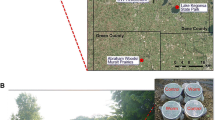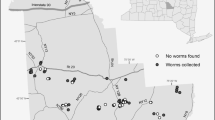Abstract
Current understanding of earthworm invasions in North America is founded on studies of European species belonging to a single family (Lumbricidae); the ecological effects of taxa from other regions are largely unknown, despite many reports of established populations. Amynthas (Megascolecidae), a genus of invasive Asian earthworm, has increasingly been documented in North American regions lacking native earthworms. We present results from complimentary field and laboratory experiments designed to (1) evaluate potential impacts of Amynthas hilgendorfi on forest–floor nutrient cycling, leaf-litter decomposition, and soil structure, (2) compare these impacts to those of a better-understood invasive European species, Lumbricus rubellus, and (3) test for interactive effects between these species. While each species increased litter-decomposition rates in laboratory mesocosms, the effect of L. rubellus was greater than that of A. hilgendorfi. Each species also increased concentrations of mineral forms of soil nitrogen and phosphorus in the laboratory, and the increases caused by A. hilgendorfi were greater than those of L. rubellus. A. hilgendorfi increased mean soil aggregate size in the field while L. rubellus did not. Additionally, we determined the growth rate of A. hilgendorfi in the field and found that at 1.35 mg AFDM/day, the rate was greater than most published values for invasive European species. Treatment effects were stronger in laboratory mesocosms than field enclosures. No interactive effects between the two species were observed. These results suggest that the effects of A. hilgendorfi can be significant and, like those of European species, are undesirable from the perspective of meeting conservation goals.





Similar content being viewed by others
References
Alban DH, Berry EC (1994) Effects of earthworm invasion on morphology, carbon, and nitrogen of a forest soil. Appl Soil Ecol 1:243–249
APHA (1998) Standard methods for the examination of water and wastewater, 20th edn. American Public Health Association, Washington, DC
Arnold RE, Hodson ME, Langdon CJ (2008) A Cu tolerant population of the earthworm Dendrodrilus rubidus (Savigny, 1862) at Coniston copper mines, Cumbria, UK. Env Pollut 152:713–722
Bohlen PJ, Parmelee RW, Allen MF, Ketterings QM (1999) Differential effects of earthworms on nitrogen cycling from various nitrogen-15-labeled substrates. Soil Sci Soc Am J 63:882–890
Bohlen PJ, Scheu S, Hale CM, McLean MA, Migge S, Groffman PM, Parkinson D (2004a) Non-native invasive earthworms as agents of change in northern temperate forests. Front Ecol Environ 2:427–435
Bohlen PJ, Pelletier DM, Groffman PM, Fahey TJ, Fisk MC (2004b) Influence of earthworm invasion on redistribution and retention of soil carbon and nitrogen in northern temperate forests. Ecosystems 7:13–27
Bouché MB (1977) Strategies lombriciennes. In: Lohm U, Persson T (eds) Soil organisms as components of ecosystems. Proceedings of the VI international soil zoology colloquium of the international society of soil science (ISSS), Uppsala, Sweden, 21–25 June 1976. Swedish National Science Research Council, Stockholm, Sweden, pp 122–132
Burtelow AE, Bohlen PJ, Groffman PM (1998) Influence of exotic earthworm invasion on soil organic matter, microbial biomass and denitrification potential in forest soils of the northeastern United States. Appl Soil Ecol 9:197–202
Callaham MA Jr, Hendrix PF, Phillips RJ (2003) Occurrence of an exotic earthworm (Amynthas agrestis) in undisturbed soils of the southern Appalachian Mountains, USA. Pedobiologia 47:466–470
Callaham MA Jr, Gonzalez G, Hale CM, Heneghan L, Lachnicht SL, Zou X (2006) Policy and management responses to earthworm invasions in North America. Biol Inv 8:1317–1329
Costello DM, Lamberti GA (2008) Non-native earthworms in riparian soils increase nitrogen flux into adjacent aquatic ecosystems. Oecologia 158:499–510
Costello DM, Lamberti GA (2009) Biological and physical effects of non-native earthworms on nitrogen cycling in riparian soils. Soil Biol Biochem 41:2230–2235
Costello DM, Tiegs SD, Lamberti GA (2011) Non-native earthworms use streams as invasional corridors in Southeast Alaska watersheds harvested for timber. Biol Inv 13:177–187
Davis CO, Simmons MS (1979) Water chemistry and phytoplankton field and laboratory procedures. Special report no. 70. Great Lakes Research Division, University of Michigan, Ann Arbor, MI, USA
Drake JM (2005) Risk analysis for invasive species and emerging infectious diseases: concepts and applications. Am Midl Nat 153:4–19
Gregory SV, Swanson FJ, Mckee WA, Cummins KW (1991) An ecosystem perspective of riparian zones. Bioscience 41:540–551
Greiner HG, Costello DM, Tiegs SD (2010) Allometric estimation of earthworm ash-free dry mass from diameters and lengths of select megascolecid and lumbricid species. Pedobiologia 53:247–252
Groffman PM, Bohlen PJ (1999) Soil and sediment biodiversity: cross-system comparisons and large-scale effects. Bioscience 49(2):139–148
Groffman PM, Bohlen PJ, Fisk MC, Fahey TJ (2004) Exotic earthworm invasion and microbial biomass in temperate forest soils. Ecosystems 7:45–54
Gundale MJ (2002) Influence of exotic earthworms on the soil organic horizon and the rare fern Botrychium mormo. Cons Biol 16:1555–1561
Haimi J, Huhta V (1990) Effects of earthworms on decomposition processes in raw humus forest soil—a microcosm study. Biol Fert Soils 10:178–183
Hale CM (2007) Earthworms of the Great Lakes. Kollath Stensaas, Duluth
Hale CM, Frelich LE, Reich PB (2005a) Exotic European earthworm dynamics in northern hardwood forests of Minnesota, USA. Ecol Appl 15:848–860
Hale CM, Frelich LE, Reich PB, Pastor J (2005b) Effects of European earthworm invasion on soil characteristics in northern hardwood forests of Minnesota, USA. Ecosystems 8:911–927
Hale CM, Frelich LE, Reich PB (2006) Changes in hardwood forest understory plant communities in response to European earthworm invasions. Ecology 87:1637–1649
Hale CM, Frelich LE, Reich PB, Pastor J (2008) Exotic earthworm effects on hardwood forest floor, nutrient availability and native plants: a mesocosm study. Oecologia 155:509–518
Hendrix PF, Bohlen PJ (2002) Exotic earthworm invasions in North America: ecological and policy implications. Bioscience 52:801–811
Hendrix PF, Baker GH, Callaham MA, Damoff GA, Fragoso C, Gonzalez G, James SW, Lachnicht SL, Winsome T, Zou X (2006) Invasion of exotic earthworms into ecosystems inhabited by native earthworms. Biol Inv 8:1287–1300
Holdsworth AR, Frelich LE, Reich PB (2007) Regional extent of an ecosystem engineer: earthworm invasion in northern hardwood forests. Ecol Appl 17(6):1666–1677
Holdsworth AR, Frelich LE, Reich PB (2008) Litter decomposition in earthworm-invaded northern hardwood forests: role of invasion degree and litter chemistry. Ecoscience 15:536–544
Jones CG, Lawton JH, Shachak M (1994) Organisms as ecosystem engineers. Oikos 69:373–386
Keller RP, Cox AN, Van Loon C, Lodge DM, Herborg L, Rothlisberger J (2007) From bait shops to the forest floor: earthworm use and disposal by anglers. Am Midl Nat 158:321–328
Klok C (2007) Effects of earthworm density on growth, development, and reproduction in Lumbricus rubellus (Hoffm.) and possible consequences for the intrinsic rate of population increase. Soil Biol Biochem 39:2401–2407
Larney FJ (2008) Dry-aggregate size distribution. In: Carter MR (ed) Soil sampling and methods of analysis, 2nd edn. CRC Press, Boca Raton, pp 821–831
Larson ER, Kipfmueller KF, Hale CM, Frelich LE, Reich PB (2010) Tree rings detect earthworm invasions and their effects in northern hardwood forests. Biol Inv 12:1053–1066
Lavelle C (1998) Burrowing activity of Aporrectodea rosea. Pedobiologia 42:97–101
Maerz JC, Karuzas JM, Nuzzo VA, Blossey B (2009) Declines in woodland salamander abundance associated with non-native earthworm and plant invasions. Cons Biol 23:975–981
Mattsson BJ (2001) Relationship between multi-scale habitat features and breeding biology of ground nesting birds. MS thesis, Department of Biology, University of Minnesota, Duluth, MN, USA
McLean JC, Parkinson D (2000) Field evidence of the effects of the epigeic earthworm Dendrobaena octaedra on the microfungal community in pine forest floor. Soil Biol Biochem 32:351–360
Migge-Kleian S, McLean MA, Maerz JC, Heneghan L (2006) The influence of invasive earthworms on indigenous fauna in ecosystems previously uninhabited by earthworms. Biol Inv 8:1275–1285
Reynolds JW (1978) The earthworms of Tennessee (Oligochaeta), IV. Megascolecidae, with notes on the distribution, biology, and a key to the species in the state. Megadrilogica 3:117–179
Reynolds JW (1994) The distribution of earthworms (Annelida, Oligochaeta) in North America. In: Mishra PC, Behera N, Senapati BK, Guru BC (eds) Advances in ecology and environmental sciences. Ashish, New Delhi, pp 133–153
Reynolds JW, Wetzel MJ (2008) Terrestrial Oligochaeta (Annelida: Clitellata) in North America, including Mexico, Puerto Rico, Hawaii, and Bermuda. Megadrilogica 12:157–210
Robertson GP, Sollins P, Ellis BG, Lajtha K (1999) Exchangable ions, pH, and cation exchange capacity. In: Robertson GP, Coleman DC, Bledsoe CS, Sollins P (eds) Standard soil methods for long-term ecological research. Oxford University Press, New York, pp 106–114
Sakai AK, Allendorf FW, Holt JS, Lodge DM, Molofsky J, With KA, Baughman S, Cabin RJ, Cohen JE, Ellstrand NC, McCauley DE, O’Neil P, Parker IM, Thompson JN, Weller SG (2001) The population biology of invasive species. Ann Rev Ecol Syst 32:305–332
Scheu S, Parkinson D (1994) Effects of earthworms on nutrient dynamics, carbon turnover and microorganisms in soils from cool temperate forests of the Canadian Rocky Mountains—laboratory studies. Appl Soil Ecol 1:113–125
Snyder BA, Boots B, Hendrix PF (2009) Competition between invasive earthworms (Amynthas corticis, Megascolecidae) and native North American millipedes (Pseudopolydesmus erasus, Polydesmidae): effects of carbon cycling and soil structure. Soil Biol Biochem 41:1442–1449
Snyder BA, Callaham MA, Hendrix PF (2011) Spatial variability of an invasive earthworm (Amynthas agrestis) population and potential impacts on soil characteristics and millipedes in the Great Smoky Mountains National Park, USA. Biol Inv 13(2):349–358
Suarez ER, Pelletier DM, Fahey TJ, Groffman PM, Bohlen PJ, Fisk MC (2004) Effects of exotic earthworms on soil phosphorus cycling in two broadleaf temperate forests. Ecosystems 7:28–44
Suarez ER, Fahey TJ, Yavitt JB, Groffman PM, Bohlen PJ (2006) Patterns of litter disappearance in a northern hardwood forest invaded by exotic earthworms. Ecol Appl 16:154–165
Suthar S (2009) Vermicomposting of vegetable-market solid waste using Eisenia fetida: impact of bulking material on earthworm growth and decomposition rate. Ecol Eng 35:914–920
Tiegs SD, Akinwole P, Gessner MO (2009) Litter decomposition across multiple spatial scales in stream networks. Oecologia 161:343–351
USDA NRCS (2009) Web soil survey. http://websoilsurvey.nrcs.usda.gov/app/WebSoilSurvey.aspx. Accessed 14 Jun 2010
Zhang W, Hendrix PF, Snyder BA, Molina M, Li J, Rao X, Siemann E, Fu S (2010) Dietary flexibility aids Asian earthworm invasion. Ecology 91:2070–2079
Acknowledgments
Dave Costello provided valuable input regarding experimental design, field methods, and earthworm ecology in general. We thank Mac A. Callaham, Jr. for assistance with A. hilgendorfi identification, and Cassandra Belcher, Keith Berven, Ashley Burtner, Tim Campbell, Josh Martin, Crystal Moon, Jeff Stephens, and Andrew Stonehouse for assistance with field work and sample processing. George Gamboa provided feedback on an earlier draft of this manuscript. Catherine Starnes, Janis Bills, and Rita Perris provided administrative support, and Sheryl Hugger allowed for use of laboratory equipment. This project was funded by the Oakland University Provost’s Graduate Student Research Award given to HGG and the Oakland University Summer Research Fellowship given to Cassandra R. Belcher.
Author information
Authors and Affiliations
Corresponding author
Rights and permissions
About this article
Cite this article
Greiner, H.G., Kashian, D.R. & Tiegs, S.D. Impacts of invasive Asian (Amynthas hilgendorfi) and European (Lumbricus rubellus) earthworms in a North American temperate deciduous forest. Biol Invasions 14, 2017–2027 (2012). https://doi.org/10.1007/s10530-012-0208-y
Received:
Accepted:
Published:
Issue Date:
DOI: https://doi.org/10.1007/s10530-012-0208-y




